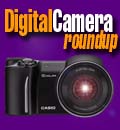 This installment of my ViewFinder column is for those new to digital cameras. Dudes and dudettes, you don't even know how lucky you are!
This installment of my ViewFinder column is for those new to digital cameras. Dudes and dudettes, you don't even know how lucky you are!
To get an awesome digicam, all you have to do is hop on over to the local Best Buy or WalMart or even corner drugstore, peruse the dozens and dozens of digital cameras vying for your attention, hand over a very reasonable amount of cash, and then go home with a marvel of digital technology, featuring five megapixel or more, a huge LCD you can easily view indoors or out, terrific battery life, and--if you so choose--all in a package smaller than the smallest Palm or Pocket PC.
Taking incredible pictures is nothing more than pressing the shutter button. The advanced electronic circuitry inside your camera does the rest. Or if your camera is so equipped, you can manually adjust settings to your heart's content. For viewing your pics you simply pop the camera's storage card into the multi-card reader of your computer and use either your favorite image browsing program or even the computer's native picture viewer. For printing you have your choice of a) sending image files directly from your computer to a online print lab; b) making hard copy on a late model printer that--via standards like PictBridge, PRINT or Exif--knows how to create the best possible picture from your camera and your computer; or c) using the printer kiosk at your local drugstore where you can zoom, crop, remove red-eye and other minor editing tasks before you decide what kinds and sizes of prints you want, and how many.
It wasn't always this way. In the olden days of digital cameras using them was, paraphrasing Bill Cosby, more like walking to school, through the snow, uphill, both ways. And unlike cars that you had to start with a crank, those olden days aren't that far in the past. We're talking just six or seven years ago.
So let's take a trip down memory lane. It'll make you appreciate just how good we have it these days.
Let's start with resolution. These days we sneer at last year's 3.2 and 4-megapixel models and wonder if the 5-megapixel camera we just bought is good enough. After all, you can now get six, eight, or ten megapixel and more. The answer is, yes, five megapixel is good enough. For a really good print you need 300 dots per inch. A 5-megapixel camera gives you 2650 x 1920 pixel images. That's more than good enough for 5x7 prints and good enough for 8x10s. Compare that with the quarter of half megapixel cameras we had back in 1998. Yes, that was 640 x 480 or 800 x 600 pixels, max. That meant ugly, grainy, blocky prints even in small formats. We were ecstatic when the magic 1-megapixel barrier was broken. Every few extra pixels meant better print quality and the extra luxury of being able to crop the picture a bit. Now we take all that for granted.
As far as LCDs goes, most of the early digital cameras had one, but they were so crappy they might as well have not been there at all. It was hard to get excited over a digicam's ability to show you the pictures instantly when you couldn't see a thing on the tiny, low-res display. And none of them were outdoor viewable. Which is really stupid since cameras are most often used outdoors. Compare that with the terrific, razor-sharp LCDs we now get even in low cost and very compact cameras. The big 2.5-inch LCD of the compact 5-megapixel Olympus Stylus 500 takes up most of the little camera's backside. And it's as viewable outdoors as it is indoors. Further, its 215,000 pixels mean it displays almost 260 pixels per inch, more than twice as many as an ultra-high-res notebook LCD.
Battery life used to be the bane of every digital camera user's existence. The power demands of those early cameras were such that standard Alkaline AA batteries were drained below a useful threshold after just a few pics. You could buy Lithium batteries but they cost a fortune and didn't last all that much longer. Even proprietary battery packs had disappointing life between recharges. It was so bad in those days that I always carried a bunch of spares and rarely ever turned on the LCD. What with ever larger displays and other electronic wizardry, battery technology remains a challenge even today, but things are getting a whole lot better. Even a set of alkalines can now last for hundreds of pictures.
Speed--or rather the lack of it--used to be a big issue. After you took a shot, early digital cameras took forever to be ready for the next picture. And pushing the shutter didn't mean you took a picture. It simply meant that you informed the camera to please take a picture when it was good and ready. Which often took seconds. The result was plenty of frustration and a lot of missed shots. That has changed dramatically. Start-up and recycle time between pictures are much, much quicker now.
Then there was the problem with getting pictures out of the camera and into the computer. USB was in its infancy and not too many PCs had it back in 1999. And even if USB was available, you couldn't take a good and reasonably fast connection for granted. These days, everyone has USB and it almost always works. And if you don't want to deal with cables, most computers now have card readers. No problem anymore at all.
Digital has come a very long way indeed. If you just get into the game don't think it was always this good. Isn't progress great?








